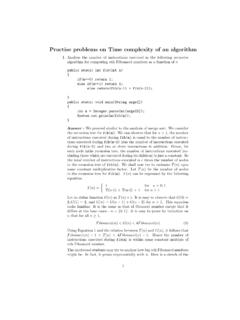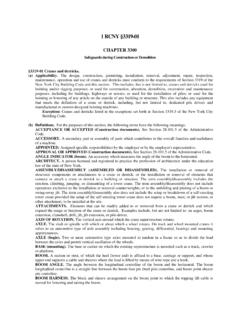Transcription of X-Ray Diffraction (XRD)
1 X-Ray Diffraction (XRD) Debjani Banerjee Department of Chemical Engineering IIT Kanpur X-Ray Generation & typical spectrum Conventional X-Ray Source & Synchrotron: Absorption (Heat) Incident X-rays SPECIMEN Transmitted beam Fluorescent X-rays Electrons Compton recoil Photoelectrons Scattered X-rays Coherent From bound charges Incoherent (Compton modified) From loosely bound charges The coherently scattered X-rays are the ones that are important from XRD perspective. Interaction of X-rays with matter Scale of Structure Organization For electromagnetic radiation to be diffracted the spacing in the grating should be of the same order as the wavelength In crystals the typical interatomic spacing ~ 2-3 so the suitable radiation is X-rays Hence, X-rays can be used for the study of crystal structures Neutrons and Electrons are also used for Diffraction studies from materials. Neutron Diffraction is especially useful for studying the magnetic ordering in materials Beam of electrons Target X-rays A accelerating charge radiates electromagnetic radiation Diffraction Basics Mo Target impacted by electrons accelerated by a 35 kV potential shows the emission spectrum as in the figure below (schematic) The high intensity nearly monochromatic K x-rays can be used as a radiation source for X-Ray Diffraction (XRD) studies a monochromator can be used to further decrease the spread of wavelengths in the X-Ray IntensityWavelength ( ) radiationCharacteristic radiation due to energy transitionsin the atomK K Intense peak, nearly monochromaticX-ray sources with different for doing XRD studies Target Metal Of K radiation ( )
2 Mo Cu Co Fe Cr Sets Electron cloud into oscillationSets nucleus into oscillationSmall effect neglected A beam of X-rays directed at a crystal interacts with the electrons of the atoms in the crystal. The electrons oscillate under the influence of the incoming X-Rays and become secondary sources of EM radiation. The secondary radiation is in all directions. The waves emitted by the electrons have the same frequency as the incoming X-rays coherent. The emission can undergo constructive or destructive interference. XRD the first step Schematics Incoming X-raysSecondaryemissionOscillating charge re-radiates In phase with the incoming x-raysCrystalline materials are characterized by the orderly periodic arrangements of atoms. The unit cell is the basic repeating unit that defines a crystal. Parallel planes of atoms intersecting the unit cell are used to define directions and distances in the crystal.
3 These crystallographic planes are identified by Miller indices. The (200) planes of atoms in NaCl The (220) planes of atoms in NaCl The atoms in a crystal are a periodic array of coherent scatterers and thus can diffract light. Diffraction occurs when each object in a periodic array scatters radiation coherently, producing concerted constructive interference at specific angles. The electrons in an atom coherently scatter light. The electrons interact with the oscillating electric field of the light wave. Atoms in a crystal form a periodic array of coherent scatterers. The wavelength of X rays are similar to the distance between atoms. Diffraction from different planes of atoms produces a Diffraction pattern, which contains information about the atomic arrangement within the crystal X Rays are also reflected, scattered incoherently, absorbed, refracted, and transmitted when they interact with matter.
4 2012 was the 100th Anniversary of X-Ray Diffraction X-rays were discovered by WC Rontgen in 1895 In 1912, PP Ewald developed a formula to describe the passage of light waves through an ordered array of scattering atoms, based on the hypothesis that crystals were composed of a space-lattice-like construction of particles. Maxwell von Laue realized that X-rays might be the correct wavelength to diffract from the proposed space lattice. In June 1912, von Laue published the first Diffraction pattern in Proceedings of the Royal Bavarian Academy of Science. Von Laue s Diffraction pattern supported two important hypotheses X-rays were wavelike in nature and therefore were electromagnetic radiation The space lattice of crystals Bragg consequently used X-Ray Diffraction to solve the first crystal structure, which was the structure of NaCl published in June 1913. Single crystals produce spot patterns similar to that shown to the right.
5 However, powder Diffraction patterns look quite different. The Laue Diffraction pattern The second Diffraction pattern published was of ZnS. Because this is a higher symmetry material, the pattern was less complicated and easier to analyze An X-Ray powder Diffraction pattern is a plot of the intensity of X-rays scattered at different angles by a sample The detector moves in a circle around the sample The detector position is recorded as the angle 2theta (2 ) The detector records the number of X-rays observed at each angle 2 The X-Ray intensity is usually recorded as counts or as counts per second Many powder diffractometers use the Bragg-Brentano parafocusing geometry To keep the X-Ray beam properly focused, the incident angle omega changes in conjunction with 2theta This can be accomplished by rotating the sample or by rotating the X-Ray tube. X-rays scatter from atoms in a material and therefore contain information about the atomic arrangement The three X-Ray scattering patterns above were produced by three chemically identical forms SiO2 Crystalline materials like quartz and Cristobalite produce X-Ray Diffraction patterns Quartz and Cristobalite have two different crystal structures The Si and O atoms are arranged differently, but both have long-range atomic order The difference in their crystal structure is reflected in their different Diffraction patterns The amorphous glass does not have long-range atomic order and therefore produces only broad scattering features Diffraction occurs when light is scattered by a periodic array with long-range order, producing constructive interference at specific angles The electrons in each atom coherently scatter light.
6 We can regard each atom as a coherent point scatterer The strength with which an atom scatters light is proportional to the number of electrons around the atom. The atoms in a crystal are arranged in a periodic array with long-range order and thus can produce Diffraction . The wavelength of X rays are similar to the distance between atoms in a crystal. Therefore, we use X-Ray scattering to study atomic structure. The scattering of X-rays from atoms produces a Diffraction pattern, which contains information about the atomic arrangement within the crystal Amorphous materials like glass do not have a periodic array with long-range order, so they do not produce a Diffraction pattern. Their X-Ray scattering pattern features broad, poorly defined amorphous humps . Crystalline materials are characterized by the long-range orderly periodic arrangements of atoms. The unit cell is the basic repeating unit that defines the crystal structure.
7 The unit cell contains the symmetry elements required to uniquely define the crystal structure. The unit cell might contain more than one molecule: for example, the quartz unit cell contains 3 complete molecules of SiO2. The crystal system describes the shape of the unit cell The lattice parameters describe the size of the unit cell The unit cell repeats in all dimensions to fill space and produce the macroscopic grains or crystals of the material The Diffraction pattern is a product of the unique crystal structure of a material The crystal structure describes the atomic arrangement of a material. The crystal structure determines the position and intensity of the Diffraction peaks in an X-Ray scattering pattern. Interatomic distances determine the positions of the Diffraction peaks. The atom types and positions determine the Diffraction peak intensities.
8 Diffraction peak widths and shapes are mostly a function of instrument and microstructural parameters. Diffraction pattern calculations treat a crystal as a collection of planes of atoms Each Diffraction peak is attributed to the scattering from a specific set of parallel planes of atoms. Miller indices (hkl) are used to identify the different planes of atoms Observed Diffraction peaks can be related to planes of atoms to assist in analyzing the atomic structure and microstructure of a sample A Brief Introduction to Miller Indices The Miller indices (hkl) define the reciprocal axial intercepts of a plane of atoms with the unit cell The (hkl) plane of atoms intercepts the unit cell at a/ , / , and / The (220) plane drawn to the right intercepts the unit cell at a, b, and does not intercept the c-axis. When a plane is parallel to an axis, it is assumed to intercept at ; therefore its reciprocal is 0 The vector dhkl is drawn from the origin of the unit cell to intersect the crystallographic plane (hkl) at a 90 angle.
9 The direction of dhkl is the crystallographic direction. The crystallographic direction is expressed using [] brackets, such as [220] The Diffraction peak position is a product of interplanar spacing, as calculated by Bragg s law Bragg s law relates the Diffraction angle, 2 , to dhkl In most diffractometers, the X-Ray wavelength is fixed. Consequently, a family of planes produces a Diffraction peak only at a specific angle 2 . dhkl is a geometric function of the size and shape of the unit cell dhkl is the vector drawn from the origin to the plane (hkl) at a 90 angle. dhkl, the vector magnitude, is the distance between parallel planes of atoms in the family (hkl) Therefore, we often consider that the position of the Diffraction peaks are determined by the distance between parallel planes of atoms. The Diffraction peak intensity is determined by the arrangement of atoms in the entire crystal The structure factor Fhkl sums the result of scattering from all of the atoms in the unit cell to form a Diffraction peak from the (hkl) planes of atoms.
10 The amplitude of scattered light is determined by: where the atoms are on the atomic planes this is expressed by the fractional coordinates xj yj zj what atoms are on the atomic planes the scattering factor fj quantifies the efficiency of X-Ray scattering at any angle by the group of electrons in each atom The scattering factor is equal to the number of electrons around the atom at 0 , the drops off as increases Nj is the fraction of every equivalent position that is occupied by atom j Bragg s law provides a simplistic model to understand what conditions are required for Diffraction . For parallel planes of atoms, with a space dhkl between the planes, constructive interference only occurs when Bragg s law is satisfied.
















